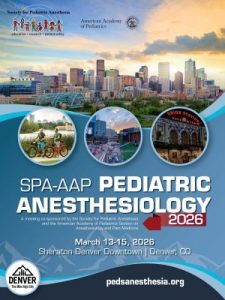Written by Myron Yaster, MD
We lost a giant this week, Dr. Estela Melman (1939-2022),1 who passed away after a tragic traumatic injury. If there was such a thing as an international Mount Olympus of Pediatric Anesthesia, Estela would be a prominent figure carved into that stone. Often thought of as the “mother of pediatric anesthesia in Mexico”, Dr. Melman overcame enormous sexist and anti-semitic obstacles to pioneer the modern practice of anesthesia in Mexico. She inspired generations of anesthesiologists, pediatricians, and surgeons in Mexico and internationally. Despite her enormous contributions to anesthesia and critical care medicine, she remained a remarkably humble and gracious mentor, colleague, and friend. I had several opportunities of meeting Estela and her beloved husband, Dr. Guillermo Bierzwinsky, at SPA annual meetings and as an invited visiting professor. Their kindness and love for each other, medicine, and Mexico were an inspiration to me and I will truly miss her.
Perhaps her most internationally important contribution to pediatric anesthesia was her pioneering work with regional anesthesia in children. It may be hard for many of you to believe but until the 1980s regional anesthesia was rarely used in pediatric anesthesia practice. Working initially in a cadaver laboratory to determine the doses of local anesthetic needed to achieve satisfactory dermatomal spread, and then with children in IRB‐approved research trials, Dr. Melman was among the first to demonstrate the effectiveness of neural blockade, particularly the caudal approach to the epidural space, in pediatric anesthesia.2 Indeed, her original study was met with substantial skepticism and was rejected by one of the editors at Anesthesia and Analgesia. According to Melman, the editor wrote that “regional anesthesia in pediatrics would never be accepted in the United States nor any of the developed countries and would be of interest only in underdeveloped countries like Mexico.” Fortunately, others on the editorial board disagreed and the published manuscript2 revolutionized care, making pediatric regional anesthesia and caudal blockade ubiquitous throughout the world.
Aside from her leadership roles in the Mexican College of Anesthesiologists and the National Board of Certification in Anesthesia, she was a member of the Mexican National Academy of Medicine (Academia Nacional de Medicina), the Mexican Academy of Pediatrics (Academia Mexicana de Pediatría), the Federation of Mexican Colleges of Anesthesiologists (part of the WFSA), and the Mexican Society for Pediatric Anesthesiologists. Finally, she was a member of the American Academy of Pediatrics, the American Society of Anesthesiologists, the American Society of Regional Anesthesia and Pain Medicine, and was a founding member of the Society for Pediatric Anesthesia.
I haven’t given justice in recounting her amazing journey and her contributions in this PAAD. I would urge all of you to read her story, which was published in the Journal of Pediatric Anesthesia as part of an ongoing history project.1
- Melman E, Arenas JA, Tandazo WE. Caudal anesthesia for pediatric surgery. An easy and safe method for calculating dose requirements. Anesthesiology. 1985;63:3A, 463.
- Melman E, Arenas JA, Tandazo WE. Caudal anesthesia for pediatric surgery. An easy and safe method for calculating dose requirements. Anesthesiology. 1985;63:3A, 463.
